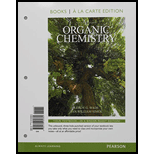
Concept explainers
(a)
To determine: The product obtained from the reaction of triolein with
Interpretation: The product obtained from the reaction of triolein with
Concept introduction: The mixture of sodium hydroxide (Strong base) and water is used to convert ester into an ester salt of metallic sodium. The mechanism of the reaction comprises three steps. The first step is the addition of nucleophile. The second step is elimination of the leaving group. The third step is the deprotonation of
(b)
To determine: The product obtained from the reaction of triolein with
Interpretation: The product obtained from the reaction of triolein with
Concept introduction: Hydrogen gas in the presence of metal catalyst is used to reduce
(c)
To determine: The product obtained from the reaction of triolein with
Interpretation: The product obtained from the reaction of triolein with
Concept introduction: The reaction of an
(d)
To determine: The product obtained from the reaction of triolein with ozone and then dimethyl sulphide.
Interpretation: The product obtained from the reaction of triolein ozone and then dimethyl sulphide is to be stated.
Concept introduction: Ozonolysis is the oxidative cleavage of the double bond, where
(e)
To determine: The product obtained from the reaction of triolein with warm
Interpretation: The product obtained from the reaction of triolein with warm
Concept introduction: Potassium permanganate is a strong oxidising agent. In hot water it cleaves unsaturated hydrocarbon and convert it into acid.
(f)
To determine: The product obtained from the reaction of triolein with
Interpretation: The product obtained from the reaction of triolein with
Concept introduction: Simmons-smith reactions are those in which methylene iodide reacts with zinc-copper to gives a carbenoid which is known as Simmons-smith reagent. This carbenoid reacts with an alkene to give cyclopropane product.
Want to see the full answer?
Check out a sample textbook solution
Chapter 25 Solutions
Organic Chemistry, Books a la Carte Edition (9th Edition)
- The molar absorptivity of a protein in water at 280 nm can be estimated within ~5-10% from its content of the amino acids tyrosine and tryptophan and from the number of disulfide linkages (R-S-S-R) between cysteine residues: Ε280 nm (M-1 cm-1) ≈ 5500 nTrp + 1490 nTyr + 125 nS-S where nTrp is the number of tryptophans, nTyr is the number of tyrosines, and nS-S is the number of disulfide linkages. The protein human serum transferrin has 678 amino acids including 8 tryptophans, 26 tyrosines, and 19 disulfide linkages. The molecular mass of the most dominant for is 79550. Predict the molar absorptivity of transferrin. Predict the absorbance of a solution that’s 1.000 g/L transferrin in a 1.000-cm-pathlength cuvet. Estimate the g/L of a transferrin solution with an absorbance of 1.50 at 280 nm.arrow_forwardIn GC, what order will the following molecules elute from the column? CH3OCH3, CH3CH2OH, C3H8, C4H10arrow_forwardBeer’s Law is A = εbc, where A is absorbance, ε is the molar absorptivity (which is specific to the compound and wavelength in the measurement), and c is concentration. The absorbance of a 2.31 × 10-5 M solution of a compound is 0.822 at a wavelength of 266 nm in a 1.00-cm cell. Calculate the molar absorptivity at 266 nm.arrow_forward
- How to calculate % of unknown solution using line of best fit y=0.1227x + 0.0292 (y=2.244)arrow_forwardGiven a 1,3-dicarbonyl compound, state the (condensed) formula of the compound obtaineda) if I add hydroxylamine (NH2OH) to give an isooxazole.b) if I add thiosemicarbazide (NH2-CO-NH-NH2) to give an isothiazole.arrow_forwardComplete the following acid-base reactions and predict the direction of equilibrium for each. Justify your prediction by citing pK values for the acid and conjugate acid in each equilibrium. (a) (b) NHs (c) O₂N NH NH OH H₁PO₁arrow_forward
- 23.34 Show how to convert each starting material into isobutylamine in good yield. ཅ ནད ཀྱི (b) Br OEt (c) (d) (e) (f) Harrow_forwardPlease help me Please use https://app.molview.com/ to draw this. I tried, but I couldn't figure out how to do it.arrow_forwardPropose a synthesis of 1-butanamine from the following: (a) a chloroalkane of three carbons (b) a chloroalkane of four carbonsarrow_forward
- Select the stronger base from each pair of compounds. (a) H₂CNH₂ or EtzN (b) CI or NH2 NH2 (c) .Q or EtzN (d) or (e) N or (f) H or Harrow_forward4. Provide a clear arrow-pushing mechanism for each of the following reactions. Do not skip proton transfers, do not combine steps, and make sure your arrows are clear enough to be interpreted without ambiguity. a. 2. 1. LDA 3. H3O+ HOarrow_forwardb. H3C CH3 H3O+ ✓ H OHarrow_forward
 Organic ChemistryChemistryISBN:9781305580350Author:William H. Brown, Brent L. Iverson, Eric Anslyn, Christopher S. FootePublisher:Cengage Learning
Organic ChemistryChemistryISBN:9781305580350Author:William H. Brown, Brent L. Iverson, Eric Anslyn, Christopher S. FootePublisher:Cengage Learning
